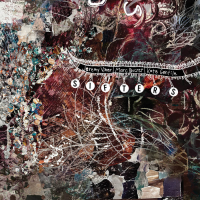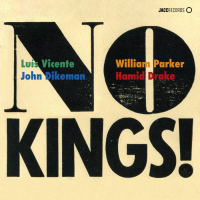Home » Jazz Articles » Album Review » Wayne Shorter: Emanon
Wayne Shorter: Emanon
The project is a musical and visual package: a triple album of original music by Shorter accompanied by a graphic novel written by Shorter with Monica Sly and illustrated by Randy DuBurke. It is a physical-only release available in two versions; a Standard Edition that packages three CDs with the graphic novel, and a Deluxe Edition that packages three 180g vinyl LPs and three CDs with the graphic novel enclosed in a hardcover slipcase. Emanon (which is "no name" backwards) is the title of the four-movement suite for the Wayne Shorter Quartet with the 34-piece Orpheus Chamber Orchestra that makes up the first of the three discs in the set, as well as the title character in the graphic novel that accompanies the music.
The 50-minute suite for quartet and chamber orchestra is certainly the centerpiece of the set. Shorter has long had a special status as a composer, and this work may be his crowning achievement so far. His orchestral writing sounds like 20th century American music (think of someone like Aaron Copland). As Shorter mentions in the liner notes, there is no attempt to "make the strings swing"—the point is to bring the classical and jazz worlds together, each on their own terms. However, the four movements do not come out of the blue. The opening movement "Pegasus" appeared in a different form on Without a Net (Blue Note Records, 2013) with the Quartet supported by the woodwind and brass ensemble Imani Winds. Closing movement "The Three Marias" was first recorded on Atlantis (Columbia, 1985), the most compositionally oriented of Shorter's solo albums.
But the arrangements here are more expansive, and the four pieces together make a unified impression. The new orchestration of "Pegasus" keeps the exploratory quartet opening—this time with Shorter's soprano saxophone heavily featured—but the orchestral entry is thrilling, giving a much bigger effect than the previous wind quintet version. As the only movement in the suite that does not also receive quartet treatment on the live discs in the set, it is also possibly the one with the most fully integrated orchestra part: there is simply too much music that a jazz quartet could not adequately reproduce.
"Prometheus Unbound" opens with an orchestral fanfare, then a lyrical section incorporating piano and drums. After the rhythm section takes over, Shorter's soprano takes center stage, accompanied by the orchestra. "Lotus" takes more of a traditional concerto grosso approach: orchestra and quartet alternate (with the orchestra getting the first and last word). On concluding piece "The Three Marias" the orchestration (by Perez and Patitucci, at Shorter's request) brings in the tune's characteristic rhythm gradually, then there is a free, rubato bridge by the quartet alone. By the end quartet and orchestra are moving together towards the exultant final statement of the theme.
The remaining two discs in the set are devoted to The Wayne Shorter Quartet Live In London. Shorter's longtime group with pianist Danilo Pérez, bassist John Patitucci and drummer Brian Blade has issued a series of mostly live recordings, each more exploratory than the last. This one revisits most of the music from the suite in quartet form, making it a valuable companion to the orchestral disc. But even the older material receives an expansive, completely fresh interpretation. Neither Shorter nor his band mates have any interest in reproducing old arrangements exactly—each performance is a fresh approach, with everyone listening and reacting to each other. It truly is "free jazz."
The live performance of "The Three Marias" immediately follows the orchestral version. It runs more than twice as long, illustrating the freedom which the quartet brings to the material. It is like an extended fantasy on the tune, radically different from both the original and the orchestrated version. "Lost And Orbits Medley" completes the second disc. "Orbits" has a lot of history: originally recorded on the Miles Davis Quintet album Miles Smiles (Columbia, 1967), then on the Shorter Quartet albums Alegría (Verve, 2003) and Without a Net (Blue Note Records, 2013).
The third disc continues the live quartet sessions. In addition to "Lotus" and "Prometheus Unbound" from the suite, it includes previously recorded selections "She Moves Through the Fair" from Alegría (Verve, 2003) and "Adventures Aboard The Golden Mean" from Beyond The Sound Barrier (Verve, 2005). The "Prometheus Unbound" performance is the most expanded, running nearly twice as long as the orchestral version (although it does begin with a piano reduction of the orchestral score).
Finally, a look at the graphic novel (which at 77 pages is really more of a "graphic novella"). It is clearly intended to be an integral part of the project, as it includes credits for the recordings as well as an introduction from musician Esperanza Spaulding. It tells the story of Emanon, a man who travels to four different worlds in the multiverse, overcoming a new fear in each of them (and paralleling the four movements in the orchestral suite). While there is plenty of physical action portrayed—there is some sort of fight scene on each of the worlds, still a common comic book device to externalize character conflict—it is fundamentally a philosophical journey of self-discovery. In this way it resembles the writing of J. M. DeMatteis on his creator-owned projects like Mercy and Seekers Into The Mystery. Visually, artist Randy DuBurke's work combines realism with impressionism, recalling artists like Bill Sienkiewicz and Kent Williams. There are a couple of direct callbacks to the music, in the form of a publication called "3 Marias" in one episode, and the climax of the work, in which the reader is called on to unlock their own knowledge, wisdom and will "to take action with the courage of a Pegasus!" The graphic novel does not attempt to visualize the music—which is always a questionable goal in any case, unless the music is extremely programmatic—but offers a glimpse into Shorter's creative impulses in composing the music (since he is a coauthor).
By any measure Emanon is a major work: a hallmark in Wayne Shorter's discography, and in modern jazz. It is truly something special, in both content and format.
Track Listing
Disc I: Pegasus; Prometheus Unbound; Lotus; The Three Marias. Disc II: The Three Marias; Lost and Orbits Medley. Disc III: Lotus; She Moves through the Fair; Adventures Aboard the Golden Mean; Prometheus Unbound.
Personnel
The Orpheus Chamber Orchestra: violin I: Richard Rood, concertmaster, Martha Caplin, Laura Frautschi, Joanna Jenner, Renee Jolles, Sophia Kessinger; violin II: Calvin Wiersma, principal, Ronnie Bauch, Adela Pena, Eriko Sato; viola: Dov Scheindlin, principal, Mark Holloway, Daniel Panner, Nardo Poy; cello: Eric Bartlett, principal, Melissa Meell, Jonathon Spitz, James Wilson; double bass: Donald Palma, principal, Jordan Frazier; flute: Susan Palma Nidel, principal, Elizabeth Mann; oboe: James Austin Smith, principal, Alexandra Knoll; clarinet: Alan Kay, principal, Alicia Lee; bassoon: Frank Morelli, principal, Marc Goldberg; horn: Stewart Rose, principal, Julie Landsman; trumpet: Louis Hanzlik, principal, Carl Albach; trombone: Michael Powell; timpani: Maya Gunji.
Album information
Title: Emanon | Year Released: 2018 | Record Label: Blue Note Records
Tags
PREVIOUS / NEXT
Support All About Jazz
 All About Jazz has been a pillar of jazz since 1995, championing it as an art form and, more importantly, supporting the musicians who make it. Our enduring commitment has made "AAJ" one of the most culturally important websites of its kind, read by hundreds of thousands of fans, musicians and industry figures every month.
All About Jazz has been a pillar of jazz since 1995, championing it as an art form and, more importantly, supporting the musicians who make it. Our enduring commitment has made "AAJ" one of the most culturally important websites of its kind, read by hundreds of thousands of fans, musicians and industry figures every month.























